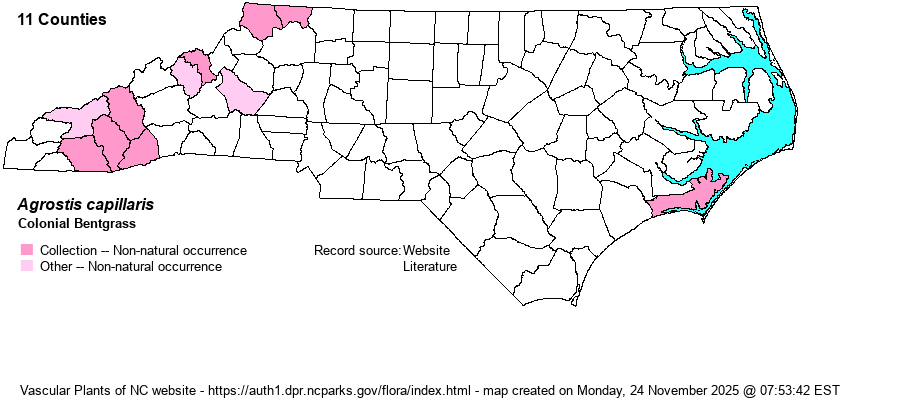| Author | L. | |
| Distribution | Mostly limited to the Mountains. Disjunct to the outer Coastal Plain (Carteret County).
Native to Eurasia; in eastern N.A. from Lab. to southern Ont., south to NC and northeastern AL. | |
| Abundance | Uncommon to perhaps rare in the Mountains; very rare elsewhere. | |
| Habitat | Roadsides, fields, lawns, disturbed places. Originally introduced as a lawn grass. | |
| Phenology | Flowering and fruiting June-August. | |
| Identification | Colonial Bentgrass grows mostly 6 inches to 2 feet tall from horizontal rhizomes or stolons. From our other bentgrasses (except A. gigantea and A. stolonifera) it differs in having a palea (vs. none). A palea is a short scale-like thing attached near the base of the lemma. From gigantea and stolonifera it differs in its shorter ligule on stem leaves (less than 3 mm long vs. 2-7 mm long). | |
| Taxonomic Comments | A synonym is A. tenuis and its var. aristata.
Bentgrasses, genus Agrostis, in NC are usually densely cespitose (many stems and basal leaves from a central area). Most leaves are basal, rather short, and slender, often folded lengthwise or involute (rounded in cross-section). Stem leaves are few in number. The inflorescence is open and airy or wispy, with 2-several branches from well-spaced nodes; towards their ends, these branches are again branched and support the spikelets. Spikelets each contain only a single floret, with 2 glumes (outer scale-like bodies) and one lemma (inner scale-like body) and a central fruit or seed. Glumes and lemmas are sharp pointed. Lemmas may or may not have a projecting awn. In grasses, the fruit is called a caryopsis or a grain; it is composed of the seed and a tightly fitting envelope (or pericarp). | |
| Other Common Name(s) | Rhode Island Bent. | |
| State Rank | SE * | |
| Global Rank | GNR | |
| State Status | | |
| US Status | | |
| USACE-agcp | FAC link |
| USACE-emp | FAC link |

